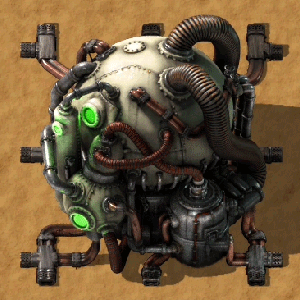Nuclear reactor
| Nuclear reactor |
|
Recipe |
|||||||||||||
| ++++ → | |||||||||||||
|
Total raw |
|||||||||||||
| +++++ | |||||||||||||
|
Map color |
|||||||||||||
|
Health |
|
||||||||||||
|
Stack size |
10 |
||||||||||||
|
1 (0.1 stacks) |
|||||||||||||
|
Dimensions |
5×5 |
||||||||||||
|
Energy consumption |
|
||||||||||||
|
Heat output |
|
||||||||||||
|
Maximum temperature |
1000 °C |
||||||||||||
|
Mining time |
0.5 |
||||||||||||
|
Prototype type |
|||||||||||||
|
Internal name |
nuclear-reactor |
||||||||||||
|
Required technologies |
|||||||||||||
|
Produced by |
|||||||||||||
|
Valid fuel |
|||||||||||||
The nuclear reactor generates heat by burning uranium fuel cells. The heat can be used in a heat exchanger to produce steam which can be used to generate power. Unlike other forms of power generation, it is load-independent - each fuel cell will always be used completely in 200 seconds, regardless of load or the temperature of the reactor.
Instead of completely consuming the fuel, burning fuel in a nuclear reactor results in used up uranium fuel cells. These used up cells can be reprocessed in a centrifuge to get back some of the uranium used to create the fuel cells.
Reactors receive an adjacency bonus for adjacent operating reactors, which increases their effective thermal output by 100% per link. This means that two reactors operating next to each other will output a total of 160MW of thermal energy, with each reactor producing 40MW base and receiving 40MW of adjacency bonus. Un-fueled reactors do not confer any bonus.
Nuclear reactors have a heat capacity of 10 MJ/C. Thus, they can buffer 5 GJ of heat energy across their working range of 500C to 1000C, and require 4.85 GJ of energy to warm up from 15C to 500C when initially placed.
History
- 0.15.0:
- Introduced
